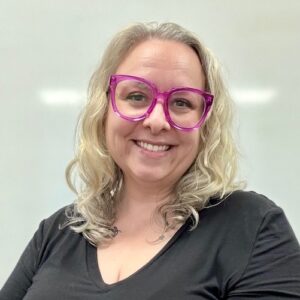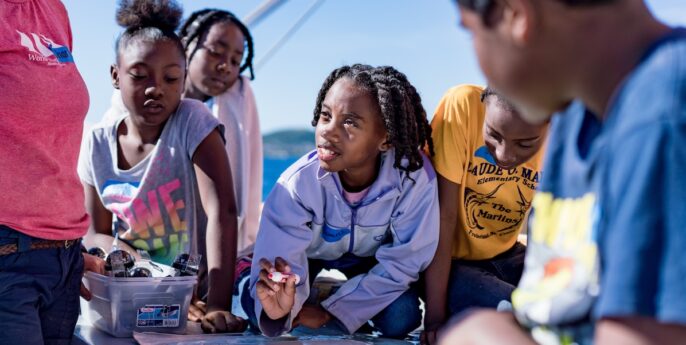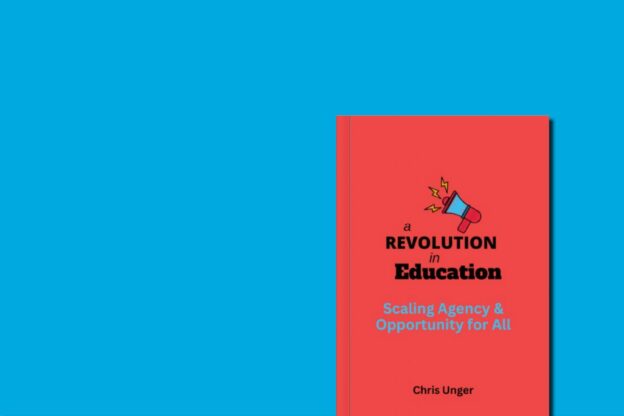At the intersection of AI advancement, systemic inequity, and an unpredictable future lies an opportunity to reimagine educational leadership. Two powerful metaphors illuminate this reimagined approach: the kaleidoscope and the workbench. Like a kaleidoscope, transformational leaders must constantly shift their perspective, allowing their identity, lived experience, and theoretical understanding to create dynamic patterns of possibility. When a kaleidoscope turns, new configurations emerge—just as leaders must help their communities discover new ways of thinking and being. The workbench represents the tactical space where these insights transform into action. Here, leaders prototype solutions, refine approaches, and craft interventions that address their communities’ unique needs. Together, these metaphors capture leadership as both an art and a craft, where continuous reflection meets practical application.
This dual nature of leadership—reflective and action-oriented—is precisely what today’s educational challenges demand. Schools, districts, higher education institutions, and workplace learning environments face unprecedented complexity: integrating rapidly evolving AI technologies, dismantling systemic inequities, and preparing humanity for a future we can barely imagine. These challenges require more than conventional leadership development—they demand a fundamental rethinking of how we prepare educational leaders to navigate complexity and drive meaningful change.
The Moravian University Ed.D. in Transformational Leadership embodies this reimagined approach. Unlike traditional doctoral programs that separate theory from practice, this program interweaves reflection and action through the lens of five learner-centered principles from Education Reimagined: agency, competency-based learning, personalized-relevant-contextualized learning, open-walled learning, and socially-embedded learning. Through these principles, leaders develop the capacity to turn their kaleidoscope of experiences while crafting solutions at their leadership workbench. This article explores how these principles come to life in the program, examining both the theoretical foundations and practical applications that are already transforming diverse learning environments. Through case studies and emerging impacts, we’ll see how this approach is equipping leaders to redesign systems for a more equitable and human-centered future.
Living the Principles: Leadership Through Experience
The Moravian Ed.D. program transforms the five learner-centered principles from theoretical constructs into lived experiences. Through intentionally designed, interconnected learning experiences, leaders discover how these principles reinforce and amplify each other, creating a powerful framework for systemic change. Each principle serves both as a lens for understanding leadership and as a practical tool for transformation, allowing leaders to deeply internalize approaches they will later implement in their own contexts.
Agency manifests through experiences that challenge leaders to move beyond traditional notions of authority and control. In Adaptive Leadership sprints, leaders critically examine workplace challenges through the lens of their own involvement in maintaining current systems. By embracing vulnerability in reflective writing and engaging in structured partner dialogues, participants uncover how their beliefs and actions might inadvertently sustain the status quo. As one participant noted, “These exercises forced me to confront my own role in perpetuating outdated practices while giving me the tools to envision and implement new approaches.” This deep engagement with agency not only builds self-awareness but also develops the confidence needed to catalyze change in complex systems.
The program’s commitment to personalized, relevant, and contextualized learning manifests in every aspect of the leader’s journey. Through structured co-design sessions, faculty collaborate with leaders to craft action research pathways that address pressing challenges in their specific contexts. An assistant principal exploring equity in support services, a corporate learning leader reimagining hybrid professional development, and a higher education administrator exploring initiatives to design for belonging, each receive tailored guidance to connect theoretical frameworks with their unique circumstances. This deliberate alignment ensures that every project, reading, and learning experience serves dual purposes: advancing the leader’s immediate work while building transferable approaches to transformation. The result is a learning journey where theory and practice aren’t just connected—they’re inseparable.
Competency-based learning in the program transcends traditional assessment models by placing leaders’ voices at the center of their developmental journey. Through structured self-reflection processes, leaders assess their growth across fourteen action research skills and mindsets, while regular updates to Leadership Manifestos and Impact Portfolios document their unique trajectory. One student wrote, “And in a sort of meta way, I have to keep reminding myself I don’t always have to collect quantitative data as we often feel compelled to do…because that’s just how we’ve been programmed to think within the larger system. It’s one of those deep-seated assumptions we need to question.” Rather than measuring progress against standardized benchmarks, leaders use their agency to determine, with faculty support, which competencies and strengths will best serve their unique contexts. They then craft personalized measures of success, treating their workbench as a laboratory for developing their leadership capacities. Progress is measured not by time spent, but by meaningful growth in areas that matter most to each leader’s transformational work.
Open-walled learning expands leaders’ perspectives beyond traditional academic boundaries through immersive experiences that illuminate systemic transformation. A visit to The High Line in New York City during the summer residency served as a powerful case study, demonstrating how collaborative leadership and adaptive thinking transformed an abandoned railway into a thriving community space. Leaders analyzed how stakeholders navigated complex challenges, challenged established norms, and reimagined possibilities—parallels they draw to their own work in educational transformation. Similarly, exploring the history of Bethlehem Steel revealed crucial lessons about organizational adaptation and the consequences of resisting change. These experiences are enriched by monthly dialogues with guest speakers and panelists who bring diverse perspectives from across sectors. From mindset experts to social entrepreneurs, these voices challenge leaders to expand their definition of what’s possible in educational transformation. Through these open-walled experiences, leaders develop new mental models for understanding and approaching systemic change.
Socially-embedded learning permeates the program’s design, fostering a vibrant community of practitioner-scholars who learn with and through each other. Through regular inquiry sessions, leaders engage in dialogical pedagogy—a collaborative approach where knowledge emerges through structured dialogue rather than traditional lecture. Together, they unpack foundational frameworks like The Three Box Strategy, The Human School Compass, and Adaptive Leadership, examining how these theories resonate within their diverse professional contexts. A leader implementing competency-based assessment might gain insights from a colleague redesigning corporate training, while another’s experience with equity initiatives sparks new thinking about community engagement. This collaborative meaning-making builds more than just understanding—it creates a network of trust, belonging, and shared purpose that amplifies each leader’s capacity to drive systemic transformation. The relationships formed through these socially-embedded experiences become a lasting resource for continued growth and innovation.
In the Moravian Ed.D. program, these five learner-centered principles aren’t just theoretical constructs—they are the lived architecture of leadership development. The principles work in concert: agency empowers leaders to drive their learning journey, which becomes deeply personalized, relevant, and contextualized to their work. This growth is measured through competency-based progression, enriched by open-walled experiences, and amplified through socially-embedded learning. This intentional integration creates a powerful learning environment where theory and practice converge, preparing leaders who don’t just understand transformation—they embody it. The following case studies illustrate how participants translate these principles into action, creating meaningful change in their professional contexts.
Leadership cannot be reduced to a standardized set of tools or competencies. Instead, it must be experienced, embodied, and lived—with each leader developing their unique capacity for transformative change.
Dr. Randy Ziegenfuss
Transforming Learning Through Action: Case Studies from the Moravian Ed.D.
Living the principles within the Ed.D. program is just the beginning—the real power emerges as leaders apply these frameworks to transform their own learning environments. Through carefully designed projects rooted in the five learner-centered principles, leaders in the Moravian Ed.D. program are beginning to create conditions for meaningful change in their diverse contexts. Their work demonstrates how theoretical understanding transforms into practical impact, as they help colleagues and stakeholders engage with new approaches to longstanding challenges. The following cases illustrate the beginnings of transformation in action, starting with a project that reimagined professional development for new teachers by leveraging technology to increase both agency and engagement.
In one PK12 learning environment, a persistent challenge emerged: how to deliver engaging, effective professional development for new teachers in a virtual environment. Traditional online PD often defaulted to passive webinars, leaving teachers disconnected and disengaged. Drawing on Malcolm Knowles’ adult learning theory and constructivist approaches, this leader redesigned the experience to put teacher agency and personalization at the center.
The transformational work reimagined Zoom sessions as collaborative learning spaces where teachers actively shaped their development journey. At the start of each module, teachers selected focus areas relevant to their immediate classroom needs—from classroom management to student engagement strategies. Interactive tools like breakout rooms and collaborative whiteboards transformed passive listening into active co-creation of knowledge. Teachers worked in small groups to analyze classroom scenarios, share successful strategies, and prototype solutions to common challenges.
Two principles particularly drove this transformation. Agency manifested as teachers moved from passive recipients to active owners of their learning—choosing topics, contributing expertise, and directing their growth. The personalized, relevant, and contextualized nature of the experience emerged through teachers selecting challenges from their own classrooms and co-creating solutions applicable to their specific contexts. Through this approach, professional learning transformed from an imposed process to a teacher-driven journey of growth.
In a corporate learning environment, leaders faced a critical challenge: balancing the need for scaled digital learning with employees’ desire for personalized development experiences. Traditional one-size-fits-all digital platforms often led to low engagement and limited application of learning. Informed by user experience design principles and adult learning theory, this leader undertook a systematic redesign of the learning ecosystem.
The transformational work began with deep listening—conducting surveys, interviews, and focus groups to understand learner preferences and pain points. The resulting intervention created flexible pathways that combined synchronous and asynchronous learning opportunities. Scientists could choose learning formats aligned with their preferences while accessing a curated digital resource library. Regular feedback loops and collaborative design sessions ensured the learning experience evolved with learner needs. Most significantly, the project established communities of practice where scientists shared expertise and co-created learning resources.
Two principles anchored this transformation. Personalized, relevant, and contextualized learning emerged through tailored pathways that respected scientists’ expertise and learning preferences. The socially-embedded nature of the intervention manifested in the collaborative design process and peer learning communities, shifting learning from an isolated activity to a collective endeavor. Through this approach, digital learning evolved from a standardized requirement to a dynamic, community-driven experience.
In a higher education music program, a persistent challenge emerged: how to help students manage performance anxiety while developing their artistic voice. Traditional approaches focused solely on technical skill development, overlooking the emotional and psychological dimensions of musical performance. Drawing on research in mindfulness and performance psychology, this leader designed an integrated approach to musician development.
The transformational work embedded mindfulness practices directly into individual music lessons. The intervention began with simple breathing exercises and centering techniques, gradually expanding to include visualization and pre-performance routines. Each practice was tailored to address specific challenges—from audition anxiety to creative blocks. Regular reflection sessions helped students identify triggers and develop personalized coping strategies. Faculty collaboration sessions created spaces to share successful approaches and adapt techniques for different instruments and performance contexts.
Two principles guided this transformation. Personalized, relevant, and contextualized learning manifested through individually tailored mindfulness practices that addressed each student’s unique performance challenges. Agency emerged as students learned to recognize their stress patterns and actively choose appropriate regulation strategies, moving from passive recipients of instruction to confident managers of their own performance experience. Through this approach, music education transformed from a purely technical pursuit to a holistic journey of artistic development.
Across these diverse contexts—from PK12 professional development to corporate learning environments to higher education—leaders are demonstrating how learner-centered principles catalyze meaningful change. Each case reveals a common pattern: when leaders deeply understand and thoughtfully apply these principles, they begin to create conditions for transformation that ripple beyond their immediate intervention. Teacher professional development shifts from passive to active engagement, corporate learning evolves from standardized to community-driven experiences, and music education expands from technical training to holistic development. While these cases represent early steps in longer journeys of transformation, they illustrate the power of reimagining leadership through a learner-centered lens. They remind us that transformation begins not with sweeping reforms, but with carefully designed interventions that shift mindsets and create new possibilities.
Conclusion
The Moravian University Ed.D. in Transformational Leadership demonstrates that reimagining leadership development isn’t just possible—it’s essential for meeting today’s educational challenges. By fully embedding the five learner-centered principles, the program creates a unique alchemy where theory and practice merge to foster genuine transformation.
The early evidence is compelling. Leaders are already redesigning professional learning environments, reimagining student support systems, and transforming approaches to growth and development. These changes, though still emerging, show how learner-centered principles can guide the redesign of educational systems at every level. From PK12 classrooms to corporate learning spaces, leaders are proving that transformation begins with reimagining what’s possible.
Like a kaleidoscope, each leader’s unique experiences and insights combine with theory and practice to create innovative patterns of possibility. But it’s at their individual leadership workbenches where these patterns transform into reality. Unlike traditional programs that provide standardized tools and predetermined solutions, the Moravian Ed.D. offers leaders a rich array of theoretical frameworks, practical approaches, and adaptive strategies. Each leader selects, combines, and adapts these tools to craft solutions unique to their context and challenges. Some might reach for design thinking methodologies while others gravitate toward participatory action research. Some might employ narrative inquiry while others leverage systems mapping. The workbench becomes a deeply personal space where each leader’s identity, context, and aspirations shape their approach to transformation.
This dual nature of leadership—reflective and action-oriented—is precisely what today’s unprecedented challenges demand. As leaders navigate the integration of AI technologies, work to dismantle systemic inequities, and prepare learning communities for an unpredictable future, they need both the kaleidoscope’s ability to reveal new patterns of possibility and the workbench’s capacity to transform those possibilities into reality. The five learner-centered principles provide the framework for this transformative work: agency empowers leaders to take bold action, competency-based approaches ensure deep mastery, personalization connects theory to context, open-walled experiences broaden perspective, and socially-embedded learning amplifies collective impact.
As the first cohort approaches graduation in 2026, their diverse approaches to change validate a crucial insight: preparing leaders to reimagine systems begins with reimagining how we prepare them. Leadership cannot be reduced to a standardized set of tools or competencies. Instead, it must be experienced, embodied, and lived—with each leader developing their unique capacity for transformative change. The future of education demands leaders who can both envision new possibilities and create the conditions for transformation. This journey begins at the workbench, where reflection leads to action, where theory meets practice, and where each leader crafts their unique path toward systemic change. For it is here, at the intersection of reflection and action, that the future of education takes shape—one leader, one workbench, one transformation at a time.






